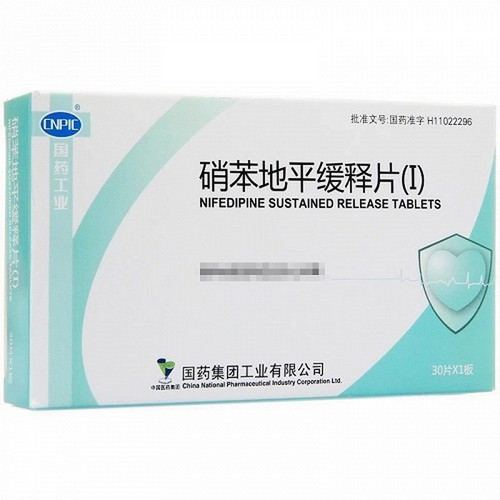Product Overview
[Drug Name]
Generic Name: Nifedipine Sustained-Release Tablets (I)
Trade Name: Tianhaili
English Name: Nifedipine Sustained-Release Tablets
Chinese Pinyin: xiaobendipinghuanshibomoyipian
[Ingredients]
Main ingredient: Nifedipine. Molecular formula: C₁ₐH₁₈N₂O₆. Molecular weight: 346.34
[Properties]
Properties: This product is a film-coated tablet that appears yellow after the film coating is removed.
[Indications]
1. Hypertension (alone or in combination with other antihypertensive drugs). 2. Angina pectoris: especially variant angina.
[Dosage and Administration]
1. Swallow the tablet whole on an empty stomach; do not chew or break it into pieces.
2. Start with a low dose. The initial dose is 20 mg/time, and the maximum dose is 60 mg/time, once daily. The maximum daily dose should not exceed 120 mg.
3. The dose of nifedipine should be adjusted gradually based on the patient's tolerance and control of the angina. Monitor the patient's blood pressure before increasing the dose. If the patient's symptoms are significant, the dose adjustment period may be shortened based on the patient's response to the drug. 4. Even if no rebound symptoms are observed upon discontinuation of the drug, the dose should still be gradually reduced, and the patient's condition should be closely monitored. 5. The dose of the standard formulation can be safely substituted for the dose of the extended-release formulation. For example, a 30 mg standard formulation three times daily can be replaced with a 90 mg extended-release formulation once daily.
[Adverse Reactions]
1. Common adverse reactions include peripheral edema (dose-proportional) and headache. 2. Adverse reactions of uncertain relevance to this product: dizziness; nausea; constipation; fatigue; facial flushing and hot sensation. 3. 1%-3% adverse reactions: chest pain; leg pain; paresthesia; vertigo; rash; leg cramps; epistaxis; rhinitis; impotence; and frequent urination. 4.1% Adverse Reactions: Cellulitis; chills; facial edema; neck pain; pelvic pain; atrial fibrillation; bradycardia; cardiac arrest; premature beats; hypotension; palpitations; phlebitis; postural hypotension; tachycardia; anxiety; decreased libido; depression; insomnia; somnolence; pruritus; night sweats; abdominal pain; diarrhea; dry mouth; dyspepsia; esophagitis; bloating; gastrointestinal bleeding; vomiting; lymphadenopathy; gout; weight loss; arthralgia.
[Contraindications]
Nifedipine is contraindicated in patients with a hypersensitivity to nifedipine.
[Precautions]
1. Hypotension: The vast majority of patients experience only mild hypotension after taking nifedipine, but some patients experience severe hypotension. This reaction often occurs during dose adjustment or increase, especially when taking beta-blockers in combination. Blood pressure should be monitored during this period, especially when taking other antihypertensive medications. 2. Peripheral Edema: Mild to moderate peripheral edema may occur in patients proportional to the dose and is related to arterial dilation. Edema often initially develops in the lower extremities and can be treated with diuretics. For patients with congestive heart failure, it is important to determine whether the edema is due to further deterioration of left ventricular function. 3. Diagnostic Interference: Elevations of alkaline phosphatase, creatine phosphokinase, lactate dehydrogenase, aspartate aminotransferase, and alanine aminotransferase may occasionally occur with this drug. These are generally asymptomatic, but cholestasis and jaundice have been reported; platelet aggregation is decreased, bleeding time is prolonged, and a positive direct Coomb's test with or without hemolytic anemia has been reported. 4. Caution should be exercised in patients with hepatic or renal impairment or those currently taking beta-blockers. A low dose should be initiated to prevent the induction or exacerbation of hypotension and an increased risk of angina, heart failure, or even myocardial infarction. Reversible increases in blood urea nitrogen and creatinine may occasionally occur with this drug in patients with chronic renal failure, but the relationship to nifedipine is unclear.
[Use in Special Populations]
Precautions for Children: Contraindicated in children.
Precautions for Pregnancy and Lactation: Contraindicated during pregnancy.
Precautions for Elderly Patients: This study has not been conducted and no reliable references are available.
[Drug Interactions]
1. When used in combination with nitrates, it controls angina attacks and is well tolerated. 2. When used in combination with beta-blockers, this drug is well tolerated and effective in most patients, but some may induce and aggravate hypotension, heart failure, and angina. 3. When used in combination with digitalis, blood digoxin concentrations may increase. Therefore, digoxin blood concentrations should be monitored during initial use, dose adjustments, or discontinuation of this drug. 4. When used in combination with highly protein-bound drugs, such as dicoumarols, phenytoin, quinidine, quinine, and warfarin, the free concentrations of these drugs often change. 5. When used in combination with cimetidine, peak plasma concentrations of this drug are increased; therefore, dosage adjustments should be made accordingly. 6. When grapefruit juice is taken with this drug, the Cmax and AUC of this drug are increased.
Pharmacological Actions:
Nifedipine is a dihydropyridine calcium antagonist that selectively inhibits transmembrane calcium transport into myocardial and smooth muscle cells and inhibits calcium release from intracellular stores without altering plasma calcium concentration. Pharmacology: This drug can dilate coronary arteries in both normal and ischemic territories, antagonizing spontaneous or ergonovine-induced coronary artery spasm, increasing myocardial oxygen delivery in patients with coronary artery spasm, and relieving and preventing coronary artery spasm. It also inhibits myocardial contractility, reduces myocardial metabolism, and decreases myocardial oxygen consumption. Furthermore, it can dilate peripheral resistance vessels, lower peripheral resistance, reduce systolic and diastolic blood pressure, and reduce cardiac afterload. This drug can delay sinus node function and atrioventricular conduction in isolated hearts; electrophysiological studies in whole animals and humans have not shown that this drug delays atrioventricular conduction, prolongs sinus node recovery time, or slows sinus node reactivity. Toxicology (Carcinogenicity, Mutagenicity, and Reproductive Toxicity): No carcinogenicity. No mutagenicity. High doses can reduce female mouse fertility; cause teratogenesis; and induce miscarriage (increased fetal drug absorption, increased fetal mortality, and decreased neonatal survival). Administration of 2/3 to 2 times the maximum human dose to pregnant monkeys can result in small placentas and chorionic villus hypoplasia; administration of 3 times the maximum human dose to rats can cause prolonged pregnancy.
[Storage] Store in a dark, airtight container.
[Strength] 10 mg
[Packaging] 10 mg x 30 seconds/box
[Expiry Life] 36 months
[Approval Number] National Medicine Standard H61023583
[Manufacturer] Shaanxi Buchang Hi-Tech Pharmaceutical Co., Ltd.







